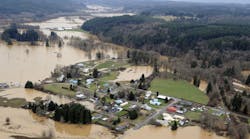NMSA, WEF celebrate first federal funding for stormwater Centers of Excellence
Congress is providing $3 million in initial funding for the establishment of three to five Centers of Excellence for Stormwater Infrastructure Technologies (CESITs), under a new program authorized in the Infrastructure and Investment in Jobs Act (IIJA) of 2021, according to a press release by the National Municipal Stormwater Alliance (NMSA).
The CESITS are research centers focused on stormwater infrastructure, which will now be established through federal funding after extensive support from the National Municipal Stormwater Alliance (NMSA) and the Water Environment Federation (WEF).
The CESITs are to:
- Conduct research on and create an inventory of new and emerging stormwater control infrastructure technologies;
- Analyze innovative financial programs supporting stormwater infrastructure implementation;
- Provide technical assistance to states, tribal communities, and local governments who want to implement innovative stormwater infrastructure technologies;
- Collaborate with educational institutions as well as public and private organizations including community-based public-private partnerships; and
- Establish and maintain a national electronic clearinghouse center to collect data and disseminate information and findings from CESITs to the stormwater sector.
“The stormwater sector is extremely data-poor, especially regarding the performance of new and emerging technologies,” says Seth Brown, Executive Director of NMSA. “These centers have the potential to bridge the gap between research and application in our sector through support of technology-focused initiatives.”
NMSA and WEF proposed the concept of creating stormwater centers of excellence as part of their annual Stormwater Policy Recommendations to Congress document, which has resulted in multiple other stormwater policy legislative successes since 2017 when the first recommendations document was released.
“This funding in the FY23 federal budget is a result of over five years of advocacy before Congress by WEF and NMSA and our members to establish stormwater centers of excellence across the nation that will help communities employ the right technologies and practices to address their local stormwater management challenges,” says Walt Marlowe, Executive Director of WEF.
Despite billions of dollars of investment over the last three decades, urban stormwater runoff remains the largest growing source of water pollution across the U.S. Additionally, studies show that there has been a significant increase in extreme rain events over the last 50 years globally and projections are that flooding's impacts are expected to accelerate in the future.
“Performance of stormwater infrastructure is critical to meeting the growing needs in the sector,” says Brown. “The CESITs could support existing efforts, such as the Stormwater Testing and Evaluation for Products and Practices (STEPP), which is a program established by WEF and now shepherded by NMSA to drive innovation in the stormwater sector by objectively, robustly, and consistently evaluating the performance of stormwater technology.”
The IIJA additionally created a stormwater planning and implementation grant program, as proposed in the recommendations document. While that program was not funded in 2023, the initial funding for the CESIT’s will help communities be ready for planning and implementation grant funding in the future.
“On behalf of WEF and NMSA, we thank Congress for creating and funding the new CESIT program,” says Marlow.” We will now work with the U.S. Environmental Protection Agency and stakeholders to ensure that the CESITs and other federal stormwater resources help communities address their stormwater management needs.”


